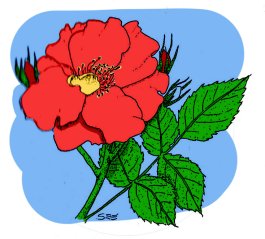Read by Matilda Longbottom

Roses have been a part of gardening history as far back as we have records. In ancient China, Babylon, India, Egypt, Greece, Rome, and Europe, we know they were grown not only for their medicinal properties but also for their beauty. In many a legend a rose was the pivotal signal of great change. In my life, too, roses changed my destiny.
I stole them from the Oxford Botanical Gardens at dusk. I needed them because I was what we called “on the rebound” and had been asked to the May Ball by a young man also on the rebound. I intended to impress my erstwhile lover who would be there with my hated replacement.
But I had no dress, so, in desperation, took a piece of black material, sewed up the sides, made a hole for the head, and slid it on. Those were the days of long chiffon ball dresses, and my creation looked like what it was, a black pillowcase, until I added the roses. I sewed them thickly round the hem, round the neck, and round the arms. Red and spiny, blood red, I went defiantly to the ball where my new young man and I danced all night with tireless energy, born of despair. The next day there was an article in the London paper about my dress and, not very long afterwards, I found myself to be pregnant.
The red roses, had I known it, were appropriate symbols of my situation. They are symbols of love, passionate love (rather than enduring love as I later came to know it). Achilles’s shield was decorated with them after he slayed Hector (as I, too, would joyfully have dispensed with my rival). Cleopatra was said to have entertained Marc Anthony on her barge with rose petals spread 18 inches thick on the decks (perilously slippery, one would have thought, but passion will find a way). Apart from Cleopatra, Egyptians provided rose petals by the ton for Roman banquets. The enthusiasm of the Emperor Heliogabalus was so great that on one occasion several guests were buried beneath the rose petals and actually suffocated.
By the time the Christian Church came to power in Europe, roses were so associated with orgies, pagan cults, and even witchcraft that at first the Church banned them completely. (They continued to be used medicinally and were said to be “good for inflamed brains.”) Gradually, however, they came to be linked with the blood of Christ and the crown of thorns. From Christ’s passion, the love of Mary came to be symbolized by roses, and from there they became an emblem of love itself. By then the double red rose was cultivated and the suggestiveness of its velvety red convoluted buds, plus the prickliness of its thorns, soon linked it to romantic or illicit love. By Victorian times, red rosebuds were coyly glowing on Valentine cards. Later, scentless and thorniness, they could be ordered by telegram and sent by air as expressions of appreciation. By the 1950′ s, the very best red velvety rose was called Chrysler Imperial, representing, once again, another passion, another love.
Even before that far-reaching episode in the Botanical Gardens, I had loved roses. My first rose bush was a miniature yellow rose given me for my ninth birthday. I had longed for it and particularly treasured it because it was the only plant to scale in my little garden. The “garden” was a six-foot-square patch carefully edged with a wall of bricks. On one side was a gap in the bricks with a plank “gate” leading into a pebble-edged path that culminated in a sunken washbowl “pond.” Apart from the rose, there were marigolds towering up proportionately to the size of exotic palm trees and nasturtiums whose leaves would have been as startling as those of the “Victoria Regina” to anyone of the size to stroll through the garden. I know now that I shouldn’t have worried about their size, and how they appeared to anyone else, for a garden is a world built to suit its creator, whether it be a raked Japanese courtyard or an immense estate.

My rose, with its miniature buds, required no special care as I remember, unless my memory has transformed it along with the rest of the enclosure. When I grew up and came to have other gardens, I assumed that roses would flourish. They were the symbol of a real garden for me, so I assumed that in any garden of mine there would be roses and that they would grow of their own accord. But in Eastern America anyway, the romantic and le(‘Js practical side of life does not apply to roses. Only in our minds can they be ethereal plants, and, apart from stories, they only really seem to flourish with neglect in old English churchyards (and one hardly likes to guess why).
Roses are a good example of the struggle between the practical and the romantic in gardening. The French, practical about love, named many of the old roses for the wives, or mistresses, of civil servants in the time of the Empress Josephine. There is also an irresistible tradition that, during the Napoleonic Wars, cargoes of roses from either side were to be sent unimpeded to their destination if the ship should fall into enemy hands. I wonder sometimes if their power to divert real war has influenced me to exclude them from a mere gardener’s war and that is why I have such difficulty getting out the spray can. The result is that the roses I get are, indeed, like exquisite babies in the ruins of bombed-out buildings, occasional perfect blooms on ravaged bushes.
Like all gardeners, I soon discovered that hybrid tea roses need to be sprayed and pruned, protected from winter and generally cosseted. It took me longer to discover that “old-fashioned” roses are not all that much easier to care for, apart from their hardiness. I imagined myself, straw-hatted, under a bower of arched branches heavy with bloom, shaking petals for potpourri into a wicker basket. “Old-fashioned” in a time of racing social change is a good selling point. Politicians in their rose garden (of well-sprayed hybrid teas) assure us that their morals are “old-fashioned” with the confidence of nurserymen’s advertisements. We are all nostalgic about the past, and the Bourbons, Mosses, Albas, Damasks, with their gentle flowers of whites, pinks, and reds, rather than the fiery modern colours, remind us of our great-grandmothers as girls in a world of fragrant posies and ordered morals.
The bushes are, however, large, arched, and thorny, mean to prune and as aggressive as Victorian imperialists. Japanese beetles eat them with relish, and many get black spot more badly than some of the resistant modern hybrids. They have to be sprayed and pruned, and one cannot wear a crinoline (or even a pair of shorts) to do it. A suit of medieval armour would be more appropriate.
Gardening is for me a curious combination of a loss of and an increase in innocence. I came to it with a belief that all nature really wishes to be a garden. Nature, which included pests, diseases, weeds, and my own inadequacies could be disillusioning but at the same time confirmed ceaselessly the beauty and strength of the growing world.
This, in terms of roses, meant I planted in innocence, seeing only potential beauty, was brought down to earth sharply, and then richly rewarded, though less perfectly than I had envisaged.
Roses have been grown, ever since gardens began. We have manipulated their beauty, bred their haunting perfume out of them, and bred it back in. We have lost some of the loveliest and have re-created some maybe even more lovely. Like the Romans, we make them bloom in winter, like the Victorians we use them to say the unsaid. We know the power of their beauty so well that the Shakers dared not even pick them with their stalks on, lest they should be distracted from medicinal thoughts.
I still have red roses in my garden, though they don’t do very well. I feel I need them. I admit, too, that I can’t regret that disgraceful episode in my own history of the rose. After all, it resulted in the birth of my darling eldest son, who had his 30th birthday party recently. I should have suggested he spread rose petals thickly on the floor as a tribute to his association with them. Who knows what the results might have been? You never can tell with roses. ❖



 Previous
Previous



Love this ❣️